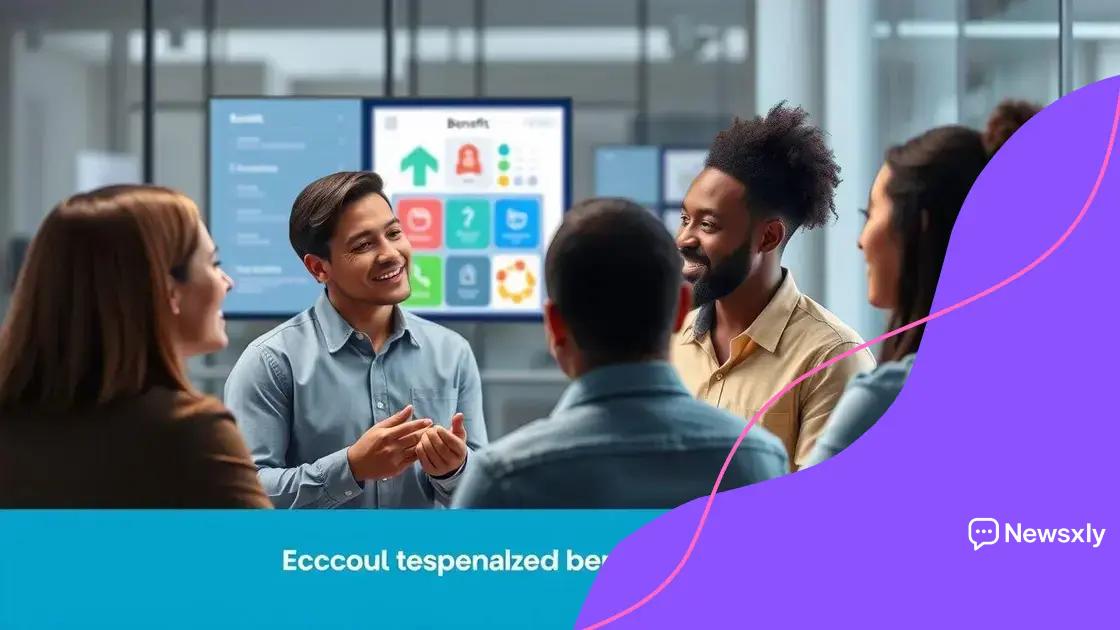Innovative approaches to employee perks that engage

Implementing innovative employee perks within your budget involves assessing employee needs, utilizing low-cost options, and engaging employees in the decision-making process to enhance job satisfaction and retention.
Innovative approaches to employee perks are changing the landscape of workplace satisfaction. Ever considered how unique benefits could boost morale and productivity? Let’s dive into the fresh ideas that can make your workplace thrive.
Understanding the importance of employee perks
Understanding the importance of employee perks is crucial for fostering a positive workplace atmosphere. These benefits not only enhance employee satisfaction, but they also contribute to overall productivity.
Benefits of Employee Perks
When companies invest in perks, they show employees that they are valued. This creates a sense of loyalty and belonging. Among the most impactful perks are:
- Health and wellness programs that encourage a healthy lifestyle.
- Flexible work hours which help employees manage their work-life balance.
- Professional development opportunities that support career growth.
- Unique perks like on-site childcare or pet-friendly policies which cater to diverse employee needs.
Another critical aspect is that employee perks can set your company apart in a competitive job market. When potential candidates see a strong benefits package, it can be a deciding factor in their job choice. Furthermore, these perks can help reduce turnover rates. When employees are happy and feel taken care of, they are less likely to leave.
Create a Customized Perks Package
To effectively implement perks, it’s essential to tailor them to your team’s needs. A survey can help identify what your employees value most. For example, some may prioritize mental health days, while others might prefer extra vacation time.
Engaging with employees about their preferences can foster an inclusive culture, where everyone feels heard. This approach not only boosts morale but can also lead to better collaboration across teams.
Ultimately, recognizing the significance of employee perks is the first step towards creating a thriving workplace. By assessing and adapting your perks package regularly, you can ensure that it meets the evolving needs of employees.
Creative perks that go beyond traditional benefits
Creative perks that go beyond traditional benefits are essential for attracting and retaining top talent. These innovative perks can significantly enhance the workplace experience and show employees that they are valued.
Examples of Creative Perks
While standard benefits like healthcare and retirement plans are important, offering creative perks can set your company apart. Here are a few ideas that can make a difference:
- Remote work options allow employees to balance their personal and work lives more effectively.
- Unlimited vacation days empower employees to take the time they need to recharge.
- Student loan repayment assistance shows a commitment to employees’ financial well-being.
- Pet-friendly offices create a relaxed environment and improve employee morale.
Incorporating these unique perks can lead to higher job satisfaction. Employees appreciate being recognized as individuals with different needs and preferences. Plus, fostering a fun and supportive workplace can drive motivation and productivity.
The Impact of Creative Perks
When organizations embrace creative perks, they create a culture of positivity. This, in turn, boosts employee engagement and fosters collaboration among teams. For example, offering professional development funds can inspire employees to explore new skills while contributing to company growth.
Moreover, providing wellness initiatives such as gym memberships or meditation classes emphasizes the importance of mental health. These perks make a significant difference in employees’ daily lives and demonstrate a genuine concern for their well-being.
As companies strive to create a more inclusive and dynamic work environment, exploring creative perks becomes a crucial strategy. By making these benefits easily accessible, employers can ensure that employees feel appreciated and motivated to perform their best.
How to personalize employee benefits effectively

Personalizing employee benefits effectively can lead to increased satisfaction and retention. Each employee has unique needs and preferences, making it crucial for companies to tailor their offerings.
Steps to Personalize Benefits
The first step is to conduct a thorough needs assessment. Surveys and one-on-one interviews can help gather insights about what benefits employees truly value. Here are some steps to follow:
- Analyze employee demographics to tailor benefits that meet the specific needs of different age groups.
- Solicit feedback regularly to stay updated on employee preferences over time.
- Offer a diverse range of benefits to cater to various lifestyles and priorities.
- Communicate clearly about the available options and how they can be personalized.
Once you have gathered sufficient data, you can begin designing a benefits package that resonates with your workforce. For instance, younger employees may appreciate student loan assistance, while older employees might value retirement planning services.
Utilizing Technology for Personalization
Another effective method to personalize employee benefits is through technology. Many companies use platforms that allow employees to choose their benefits from a list of options. This can significantly increase engagement, as employees feel more involved in the decision-making process.
Additionally, automating benefits enrollment can streamline the process and reduce errors. It also offers employees the flexibility to make changes as their needs evolve. For example, an employee might want to adjust their health benefits after having a child, indicating the importance of flexibility in benefit offerings.
Ultimately, successfully personalizing benefits is about understanding your employees and being responsive to their needs. By doing so, you not only enhance workplace satisfaction but also cultivate a culture of trust and respect.
Evaluating the impact of employee perks on retention
Evaluating the impact of employee perks on retention is essential for organizations aiming to maintain a happy and productive workforce. When perks are well-implemented, they can lead to higher employee loyalty.
Understanding Retention Rates
First, it’s important to understand how employee perks correlate with retention rates. Companies that provide attractive benefits often experience lower turnover. Employees are less likely to leave if they feel their needs are being met. A few factors that contribute to this include:
- Job satisfaction from feeling valued and appreciated.
- Opportunities for growth that come from educational perks and professional development.
- A positive work environment fostered by supportive workplace policies.
- Increased engagement from employees who feel connected to their workplace.
When evaluating the effects of perks, organizations can gather feedback through employee surveys. These surveys can help identify which perks are most valued and how they influence employee decision-making.
Metrics to Measure Impact
To accurately assess the impact, companies should analyze specific metrics. By looking at retention trends before and after implementing perks, businesses can gauge effectiveness. Key metrics to consider include:
- Turnover rates over the past few years.
- Employee satisfaction scores from surveys.
- Cost per hire and the financial ramifications of turnover.
- Engagement levels as measured by participation in company activities.
A comprehensive approach will ensure that the organization can adapt its benefits to meet employees’ changing needs. Ultimately, ensuring that perks resonate with employees can help build a loyal and committed workforce.
Implementing innovative perks within your budget
Implementing innovative perks within your budget is a challenge many organizations face. It’s important to offer benefits that attract talent without breaking the bank.
Identifying Your Budget
Start by determining what you can afford for employee perks. This involves taking a close look at your overall budget and allocating funds specifically for perks. Set realistic expectations about what you can offer. Here are some tips on managing your budget:
- Assess current spending on employee benefits to identify areas for cost-cutting.
- Involve employees in the budgeting process to understand their priorities.
- Research low-cost perks that still add value, like flexible work arrangements.
Once you have established your budget, think creatively about how to maximize your spending. Innovative perks don’t always require large funds. Many benefits can be implemented at little to no cost.
Creative Low-Cost Perks
There are many ways to enhance employee satisfaction without overspending. Consider options such as:
- Wellness initiatives like group exercise sessions or yoga classes hosted by employees.
- Recognition programs that highlight employee achievements through simple awards or shout-outs.
- Flexible hours that allow employees to manage their work-life balance without additional costs.
- Peer mentoring programs that develop skills and relationships among employees.
Implementing these kinds of perks fosters a supportive workplace culture and shows employees that you value their well-being. Regular communication about available perks can further enhance their effectiveness. Ensure everyone is aware of perks that are offered.
The key to success is being transparent about what you can provide and making employees feel involved in developing new options. This collaborative approach can lead to innovative perks that fit comfortably within your budget.
FAQ – Frequently Asked Questions about Implementing Employee Perks
What are some examples of innovative employee perks?
Examples include flexible work hours, wellness programs, and on-site childcare, which help boost morale and productivity.
How can I determine what perks my employees want?
Conduct surveys or hold discussions to gather feedback directly from employees about their preferences.
How can I implement perks within a limited budget?
Focus on low-cost options like recognition programs, flexible schedules, or wellness initiatives that enhance employee satisfaction without significant expenses.
Why is it important to involve employees in the perks decision-making process?
Involving employees fosters a sense of ownership and ensures that the benefits provided align with their actual needs and interests.





